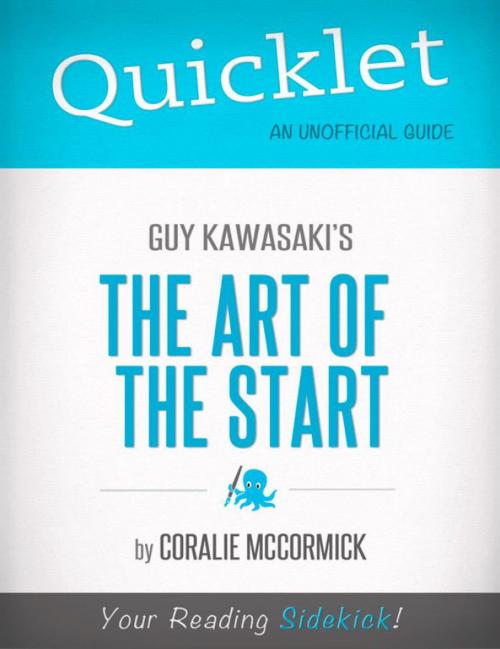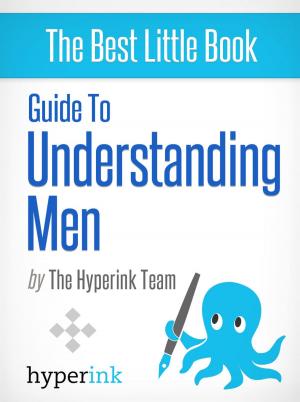Quicklet On Guy Kawasaki's The Art of the Start
Nonfiction, Reference & Language, Study Aids, Book Notes, Art & Architecture, General Art| Author: | Coralie McCormick | ISBN: | 9781484006719 |
| Publisher: | Hyperink | Publication: | February 12, 2012 |
| Imprint: | Hyperink | Language: | English |
| Author: | Coralie McCormick |
| ISBN: | 9781484006719 |
| Publisher: | Hyperink |
| Publication: | February 12, 2012 |
| Imprint: | Hyperink |
| Language: | English |
ABOUT THE BOOK
Guy Kawasaki will often talk about his condition of tinnitis. Doctors are a bit mystified about the condition that means he has a constant ringing in his right ear. They have advised him to cut back on everything from his salt intake to caffeine.
Kawasaki has another theory.
As a venture capitalist, he has to listen to pitches all the time. He has entrepreneurs and would-be entrepreneurs with 60-slide Powerpoint presentations boasting about patents that are pending, a $50 billion market, and investors that are already on board. Subsequently he has developed this condition that occasionally leads to a sense of vertigo.
In the hopes of making his life easier by giving start-ups a guide to the pitch and the abc’s of beginning their business, The Art of the Start was written. Kawasaki admits that the temptation when embarking on a project like this is to want to appear like an omniscient, all-knowing guru who never made mistakes in his career, when in fact he has. What he has used in writing his book is the hindsight of what he wished he had done at different points in his career.
MEET THE AUTHOR
Coralie would really like to travel constantly. Chasing monkeys off my balcony in the morning sounds like a great morning constitutional, and she loves finding new dishes to try in new out-of-the-way towns. When not travelling, Coralie is planning new trips, taking photographs, playing with he nephews, or writing. She has a day job that helps her pay the bills and a degree in Economics. She is also obsessed with Haruki Murakami novels and his 'words as pictures' style where sheep can talk, and you can always check yourself into the Dolphin Hotel when you need a break.
EXCERPT FROM THE BOOK
Throughout his book, Kawasaki peppers the pages with “Exercises” that he uses as useful self-checks for budding entrepreneurs to check whether or not they need to reconsider the direction they’ve chosen for their enterprise.
For instance, in the section on The Art of Positioning, Kawasaki discusses naming strategies. He lists pointers and pitfalls of the naming process. He explains that ideally your name should be able to function as a verb and the Exercise after the section immediately asks the reader to use the name of their business in this context to see if it can function as a verb.
Another tool that Kawasaki uses that is useful is the section following each chapter entitled FAQ, standing not for Frequently Asked Questions, but instead Frequently Avoided Questions. In this not-so-gentle way he reminds us that as entrepreneurs we tend to develop tunnel vision, disregarding what we dismiss as irrelevant or inconvenient. Only this works to the detriment of the budding entrepreneur as you cannot afford to ignore any facet of a growing business.
For instance, in the chapter on The Art of Writing a Business Plan, one FAQ asks: “How frequently should I rewrite my business plan?”
Buy a copy to keep reading!
ABOUT THE BOOK
Guy Kawasaki will often talk about his condition of tinnitis. Doctors are a bit mystified about the condition that means he has a constant ringing in his right ear. They have advised him to cut back on everything from his salt intake to caffeine.
Kawasaki has another theory.
As a venture capitalist, he has to listen to pitches all the time. He has entrepreneurs and would-be entrepreneurs with 60-slide Powerpoint presentations boasting about patents that are pending, a $50 billion market, and investors that are already on board. Subsequently he has developed this condition that occasionally leads to a sense of vertigo.
In the hopes of making his life easier by giving start-ups a guide to the pitch and the abc’s of beginning their business, The Art of the Start was written. Kawasaki admits that the temptation when embarking on a project like this is to want to appear like an omniscient, all-knowing guru who never made mistakes in his career, when in fact he has. What he has used in writing his book is the hindsight of what he wished he had done at different points in his career.
MEET THE AUTHOR
Coralie would really like to travel constantly. Chasing monkeys off my balcony in the morning sounds like a great morning constitutional, and she loves finding new dishes to try in new out-of-the-way towns. When not travelling, Coralie is planning new trips, taking photographs, playing with he nephews, or writing. She has a day job that helps her pay the bills and a degree in Economics. She is also obsessed with Haruki Murakami novels and his 'words as pictures' style where sheep can talk, and you can always check yourself into the Dolphin Hotel when you need a break.
EXCERPT FROM THE BOOK
Throughout his book, Kawasaki peppers the pages with “Exercises” that he uses as useful self-checks for budding entrepreneurs to check whether or not they need to reconsider the direction they’ve chosen for their enterprise.
For instance, in the section on The Art of Positioning, Kawasaki discusses naming strategies. He lists pointers and pitfalls of the naming process. He explains that ideally your name should be able to function as a verb and the Exercise after the section immediately asks the reader to use the name of their business in this context to see if it can function as a verb.
Another tool that Kawasaki uses that is useful is the section following each chapter entitled FAQ, standing not for Frequently Asked Questions, but instead Frequently Avoided Questions. In this not-so-gentle way he reminds us that as entrepreneurs we tend to develop tunnel vision, disregarding what we dismiss as irrelevant or inconvenient. Only this works to the detriment of the budding entrepreneur as you cannot afford to ignore any facet of a growing business.
For instance, in the chapter on The Art of Writing a Business Plan, one FAQ asks: “How frequently should I rewrite my business plan?”
Buy a copy to keep reading!















